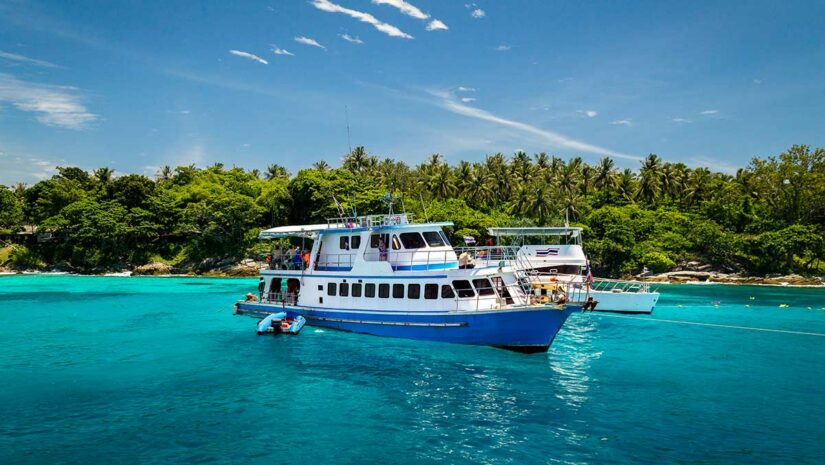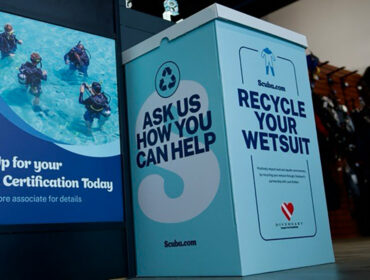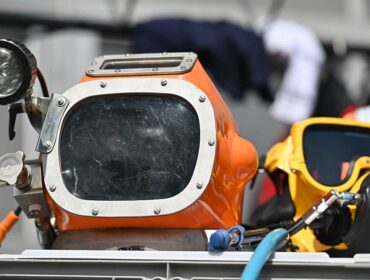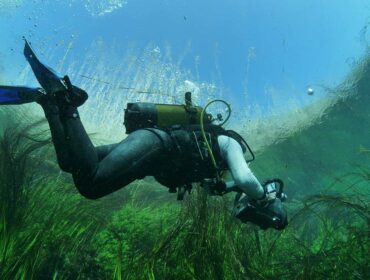The liveaboard diving experience is a must-do for anyone passionate about scuba diving, as it really tests the skills of a diver and exposes one to several different dive sites and conditions, and some of the more exotic dive sites in the world.
For a truly immersive dive experience, nothing can beat the liveaboard, a private vessel whose sole purpose is to cater to the avid scuba enthusiast. The main advantage to this type of vacation is the variety of dives you can do with minimal travel hassle. Your meals, accommodations, and activities are all provided through one reservation, leaving you only with the tasks of packing and getting there!
What is a liveaboard scuba diving trip?
A liveaboard is a larger recreational diving boat with sleeping and eating accommodations designed for multi-day dive trips. These vessels visit the more exotic out-of-the-way dive sites that aren’t usually accessible by shore-based boat day trips.

What does a liveaboard trip include?
A liveaboard vacation package will typically include your meals, non-alcoholic beverages, a room with a private bathroom, and all diving excursions, for which air will be provided. Most of these yachts feature sundecks, swimming pools, and jacuzzis from which to enjoy the seascape around you, and state-of-the-art entertainment facilities for catching a movie or hitting the dance floor. Some even offer spa services to work out all those kinks between dives!
How to Choose a Liveaboard Trip
Destination
Needless to say you’ll first need to pick a destination worthy of live-aboard diving (i.e. it should have plenty of dive sites that are not easily accessible from the shore, as that would defeat the purpose), and make sure that the diving is suitable for you skill level. Many a times as live-aboard diving takes you further out into open seas which makes for some challenging dives. That said, you always have the choice of what dives you’d like to attempt, so if you’re not feeling up to it or unsure because of conditions you can always opt out of those sites.
Engines
You’d want to be sure you reach not only your destination but make it back too, so at least two engines are in order for a good live-aboard.
Safety & Navigation
Another important thing to look for in the live-aboard vessel are its safety and navigation features. While most vessels do have these, it’s good to make sure that they have a GPS navigation, a powerful marine VHF radio and safety gear like life vests, life rafts, oxygen cylinders and a well equipped first-aid and medical kit.
You must note the exit and entry methods for the diving are of your liking when picking a live-aboard. Some vessels have swim platform that are low to the water while some larger vessels that can’t get close enough to the sites use tenders (smaller rafts) to ferry you to and from the dive site.
Accommodations
With the safety and diving out the way, accommodation is the next big thing to check out before booking a live-aboard. Remember it’s your home away from home for a few days and while the size of cabins are usually conservative it’s nice look for a spacious cabin with en-suite facilities including fresh water to shower.
Number of Divers
And lastly, you should ask about boat capacity and the number of divers they usually accommodate. It’s also good to know the number of crew, boat hands and the dive team on hand for the trip. At the end of the day your experience on board will be greatly influenced by the crew and people you meet. Having good dive guides who know the dive sites well can also make all the difference to your diving experience.
What to expect on a liveaboard dive drip
Depending on your location, you could be doing wall dives, wreck dives, coral reef exploration, or dives that are focused on specific marine animals, such as sharks or manta rays. Underwater photography is usually part of the dives, and if you forgot your camera, don’t fret — they are commonly available for rental on liveaboards that offer photography.
The entire trip doesn’t just happen at sea, though. There are plenty of land options available to you when the ship is docked. You may spend the day lounging on the beach, wandering the town, hiking in beautiful rainforests, or taking a zipline tour. Combine all the fun of a cruise with the opportunity to dive some incredible places, and you’ve got several vacations all in one, without the stress of multiple bookings!
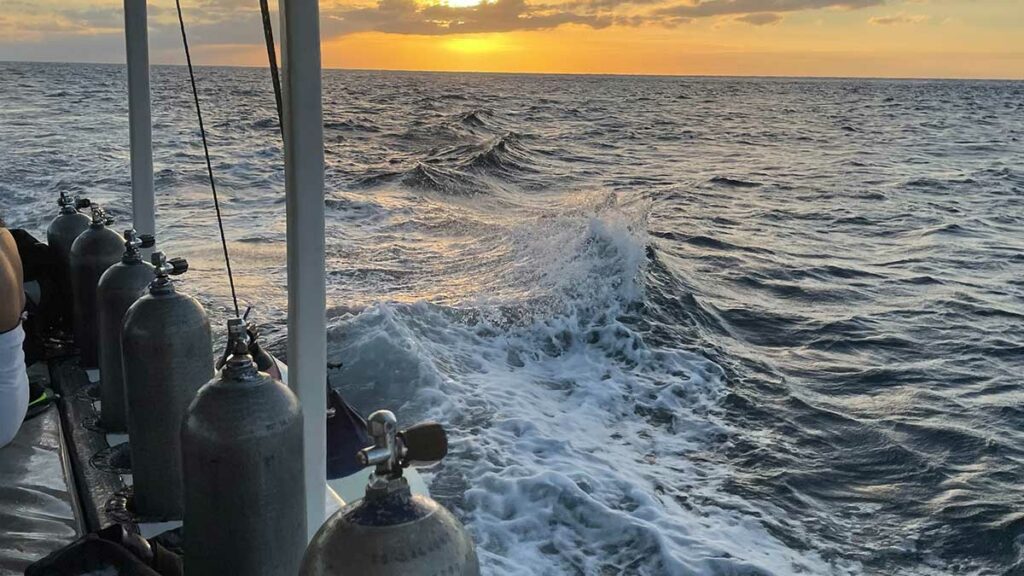
Gear You Need for a Liveaboard Diving Trip
Dive Computer
Most liveaboards mandate that each diver carry their own dive computer on all dives, and do not allow sharing, or computer-less diving. This isn’t without good reason. Since you will be doing up to 4 multi-level dives a day, it is critical that you have a computer that can compute and keep track of nitrogen loading, and provide you with no-decompression limits for each dive.
Ordinarily day trips or shore diving comprises a maximum of two dives a day, and the body has loads of time before the next day’s dives to off gas. However, on a liveaboard performing repetitive dives a dive computer can keep you within safe limits through your trip and prevent you from getting the bends. Renting a dive computer often turns out expensive in the long run, and learning how to use a new computer every trip is challenging. We recommend you purchase your own computer and familiarize yourself with using it before you set off.
Equipment Spares or a Save A Dive Kit
While most liveaboards carry dive equipment spares, you just might find yourself in the middle of the ocean with no dive shops to replace your broken mask strap, fin strap, or busted o-ring. It is highly advisable to carry some basic spares or a handy save-a-dive kit that contains commonly needed spare parts that will enable you to continue your dive and enjoy your trip in the event that you face a simple equipment failure. Mask Strap, Fin Strap, Snorkel Keeper, Silicone Mouthpiece, Tie Wrap, and O Rings are some commonly needed items in a spares kit.
Surface Marker Buoy (And Know How to Use It)
Having your own SMB (Surface Marker Buoy or Safety Sausage) and more importantly knowing how to deploy one is very important on a liveaboard trip. Often, surface conditions may be rough or choppy, or there may be strong surface currents that drag you away from your surfacing zone. A diver needs to signal the boat, or grab the captain’s attention to come pick him/her up.
Without a high visibility SMB, spotting a diver on the surface is very challenging. An SMB may be the difference between getting spotted or being left behind. It is essential that each diver carry some form of signaling device. SMB’s are also useful where there are several liveaboards, and a diver needs to signal the right boat for pickup, as well as avoid boat collision by providing a marker to surface boats that there are divers surfacing.
Batteries
If you are planning to do any underwater photography on your next liveaboard trip, make sure you stock up on plenty of extra batteries. Remember there’s no corner store in the middle of the ocean where you can run out and buy some. Try using rechargeables or carry enough disposable batteries for your camera, external strobe, your dive lights, as well as spare batteries for your dive computer should you have a user replaceable battery capability. Make enquiries regarding the availability of plug points and the type of adapter, pin-type and voltage on the boat beforehand, otherwise you may just be stuck with your recharger and no way to charge your equipment.
Dive Light
Whether you plan or not on doing a night dive, it’s always handy to have your own primary or secondary dive light handy. Not only is a dive light a great way to grab your buddy’s attention in lower visibility, but it’s also extremely handy in daylight to inspect the colors of marine creatures as you dive deeper, or peer into crevices and cracks looking for lobsters, shrimp, or other interesting creatures. Most liveaboards that do not conduct night dives will still have their last dive late in the afternoon or just before sunset when light is just as poor.
Noise-Maker or Tank Banger
While we all hate the annoying underwater horns that scare away fish and annoy our fellow divers, it is always a good idea to carry some sort of device to attract the attention of your buddy or Dive Master should you be diving in a larger group. If you are running out of air, or need to surface, or simply get your DM’s attention, then a noise-maker such as an underwater shaker, rattle or a tank banger is great to catch their attention.

Why You Should Try a Liveaboard Dive Trip
If you’re an avid diver and tend to plan your vacations around destinations you can go scuba diving, then liveaboard diving may be just the thing for you. Many people shy away from doing liveaboard trips as they look at it as being stuck with a bunch of strangers on a boat, far away from civilization and nothing but diving to do. However, there’s really no better way to get some serious diving without the hassle of hotel rooms, restaurants, transportation, and more. Here’s a look at some of the reasons why you should try diving from a liveaboard.
Liveaboards offer access to remote dive sites
Liveaboards are ideal for destinations that have plenty of dive sites that are not easily accessible from the shore. Many times, diving from a liveaboard takes you further out into open seas. This makes for some challenging dives, but also increases chances of seeing more pelagic and bigger marine life.
Out of bed and into the water
When staying and diving from a liveaboard, you don’t notice the travel to and from dive sites. You can simply enjoy the convenience of rolling out of bed and jumping straight into the water. And it works the other way too, out of the water and into a bed. No long choppy small boat rides back to shore and possibly a drive to your hotel.
You can dive as much as you want
Most liveaboards offer four to five dives per day! That is a lot of diving, and you can pretty much take your pick of how many dives you want to do each day while onboard.
Meet like-minded people
It comes as no surprise that most people you’ll find booked on a liveaboard with you, have at least one thing in common: their passion for diving. That said, it’s actually a great place to meet new people from all over the world, with different backgrounds, of different ages, and different experience levels. As diving takes up most of what you’re doing onboard, there’s always a conversation starter and before you know it, you’ll be swapping stories and experiences of all ventures of life. It’s easy to strike up friendships when you’re not just diving but also eating and staying with the same group of people for a few days.
It’s worry-free
The only thing you have on your mind when on a liveaboard trip is your next dive or remembering all the incredible creatures you have seen underwater to fill up your logbook. Everything else is taken care of for you onboard — your next meals, your next dive sites, getting to the dive sites, prepping equipment, and re-filling the scuba tanks. It’s easy to get spoiled, just diving, eating, sleeping, and soaking up the sun. Most liveaboards are prepaid too, so you don’t even have to worry about reaching for your wallet when you’re aboard in most cases.
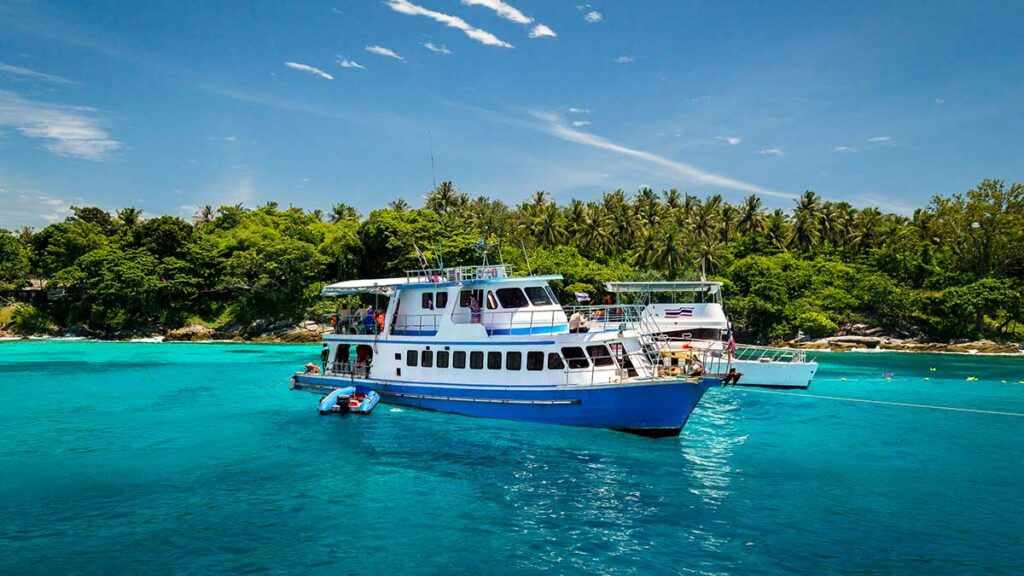
How to Prepare for a Liveaboard Dive Trip
Let’s take a look at a few skills a diver should tune up on before setting off on a liveaboard vacation.
Enhance your diving skills
If you plan to do liveaboard diving, then it is strongly advisable to be an Advanced Open Water diver with 30 or more dives under their belt. A liveaboard trip may not be the right environment to be learning your basics, though some liveaboards are designed for beginners.
Most liveaboard diving is highly demanding, and dive sites are in locations where shore boats don’t normally go. Sites can be unsheltered and rough, currents may be strong, and so a diver needs to be comfortable with their diving ability.
There are often several dives a day, so a diver would need to be very comfortable with all different diving skills, situations and conditions (night diving, descending and ascending without an anchor line, drift diving, wrecks, and caverns). Dive groups may be large with varied diving abilities, so you surely won’t have as much one-on-one supervision from your dive master. If you haven’t dived in a while then get some practice dives before you set out on a demanding liveaboard.
Perfect your buoyancy
Whether you are diving a shipwreck, or planning to pass through some nifty swim-troughs or lava tunnels underwater, mastering your buoyancy skills is a must. If there are surface currents, your dive master may require you to descend upon hitting the water immediately, or while ascending, perform a safety stop at 3 meters without the assistance of an ascent/anchor line or visual reference. All of these situations require a diver to have good buoyancy skills.
Learn to dive nitrox
A liveaboard visiting plenty of deep dive sites or shipwrecks is a great opportunity to dive Nitrox and benefit from longer no-decompressions times. The diving time allowed when using enriched air nitrox changes as the “enriched” air used has more oxygen and less nitrogen. This means that when diving nitrox, a diver’s body absorbs less nitrogen during the dive than a diver that uses regular air. Several liveaboards conduct Nitrox courses onboard, and learning to dive nitrox is a good skill to have in your diving arsenal, and will help you get the most of your dives on your trip.
Practice how to kit up and familiarize yourself with your equipment
While some liveaboards may have deckhands kit your scuba equipment for you, most require you to set up your tank, BCD, and octopus yourself before each dive. Since you will be performing numerous dives each day, even if you don’t need to kit-up each dive, you must know how to inspect your equipment before each dive. Basics like checking air-pressure, leaks, LP inflator, and regulators need to be carried out before each dive. Get familiar with using your equipment, know where everything is, and you will have no problems underwater.
Pack appropriate clothing
Depending on where your liveaboard vacation takes you, you could be soaking up the sun between dives, or you could be looking at darker skies and rain. It is important to remember that weather at sea is always subject to change, so be sure to bring warm clothing as well as shorts and bathing suits. Even in warm weather, a day of diving can chill your core, and there is nothing more comforting than a nice cushy pair of socks or a snuggly sweater.
Choose biodegradable personal care products
Select biodegradable items like shampoos and cleansers, whenever possible, and remove all merchandise from its packaging beforehand to eliminate unnecessary trash on the boat. Be conscious of the fact that you are essentially living in a micro environment. Be mindful of your use of resources and production of waste.
Do you need to be a certified diver to do a liveaboard trip?
If you’re not a certified diver, liveaboard diving is still possible. Some liveaboards provide scuba classes and certification, as well as dive equipment rentals. Many locations will require divers to be more experienced, as there may be strong currents or a more technical type of diving in the program. Always confirm the experience level required before booking a liveaboard.
Conclusion
The most important tip for a liveaboard trip? Have fun! The weather and the ocean can both be irregular, and each diver will have their own kind of experience on the boat. Some may find that the constant motion of the sea is physically upsetting, while others may realize a liveaboard trip is not what they had in mind. Remember that diving is what you’re ultimately there for, and make the most of your time while you’re there. We have no doubt that your liveaboard vacation will be one of the most unforgettable times of your life!

